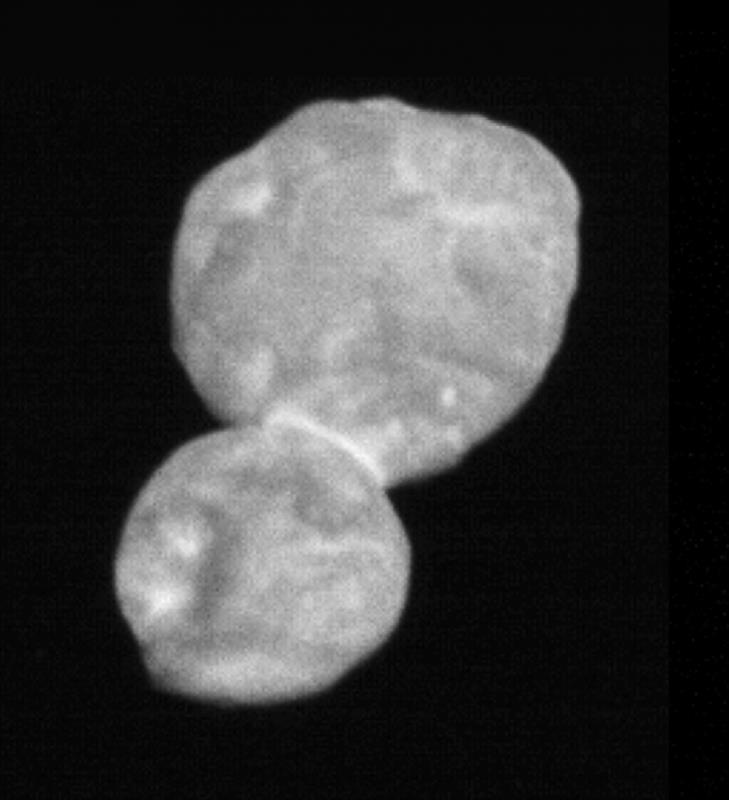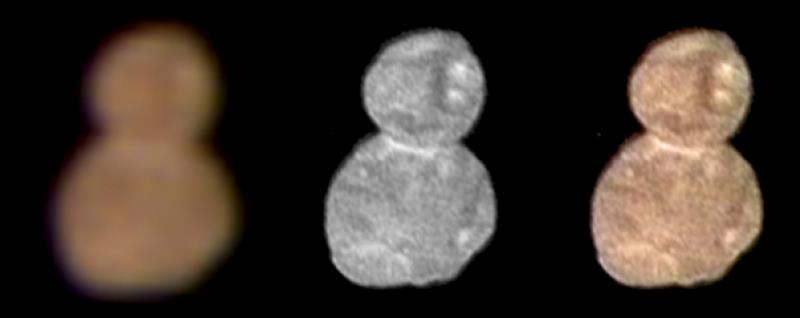Ultima Thule —meaning “beyond the borders of the known world” in Latin — resides in the Kuiper Belt, a region past Neptune that rings the planets of the solar system. The Kuiper Belt might contain hundreds of thousands of icy objects larger than 62 miles as well as “an estimated trillion or more comets,” according to NASA. These icy objects are leftovers from the creation of the solar system some 4.6 billion years ago.

This image taken by the Long-Range Reconnaissance Imager (LORRI) is the most detailed of Ultima Thule returned so far by the New Horizons spacecraft. It was taken at 5:01 Universal Time on January 1, 2019, just 30 minutes before closest approach from a range of 18,000 miles (28,000 kilometers), with an original scale of 459 feet (140 meters) per pixel. Credit: NASA/Johns Hopkins University Applied Physics Laboratory/Southwest Research Institute
Like the Voyager 1 and 2 probes, the first human-made objects to leave the solar system, New Horizons draws power from a piece of technology called a radioisotope thermoelectric generator (RTG). The spacecraft uses electricity from the RTG to snap photographs and transmit them and other mission data.
The RTG takes advantage of the predictable decay of the plutonium-238 radioisotope inside 18 fire-resistant ceramic pellets, transforming the heat given off by the plutonium into electricity via a process known as the Seebeck effect. The RTG aboard New Horizons provided about 250W of power when the probe launched in 2006. But the generator loses 5% of its power every four years.
New Horizons observed Ultima Thule from a distance of 2,200 miles. It will take the spacecraft 20 months to transmit all the information back to Earth. According to NASA, the probe will travel through the Kuiper Belt until at least 2021, hunting for clues illuminating the birth of the solar system.
 The first color image of Ultima Thule, taken at a distance of 85,000 miles (137,000 kilometers) at 4:08 Universal Time on January 1, 2019, highlights its reddish surface. At left is an enhanced color image taken by the Multispectral Visible Imaging Camera (MVIC), produced by combining the near infrared, red and blue channels. The center image taken by the Long-Range Reconnaissance Imager (LORRI) has a higher spatial resolution than MVIC by approximately a factor of five. At right, the color has been overlaid onto the LORRI image to show the color uniformity of the Ultima and Thule lobes. Note the reduced red coloring at the neck of the object. Credit: NASA/Johns Hopkins University Applied Physics Laboratory/Southwest Research Institute
The first color image of Ultima Thule, taken at a distance of 85,000 miles (137,000 kilometers) at 4:08 Universal Time on January 1, 2019, highlights its reddish surface. At left is an enhanced color image taken by the Multispectral Visible Imaging Camera (MVIC), produced by combining the near infrared, red and blue channels. The center image taken by the Long-Range Reconnaissance Imager (LORRI) has a higher spatial resolution than MVIC by approximately a factor of five. At right, the color has been overlaid onto the LORRI image to show the color uniformity of the Ultima and Thule lobes. Note the reduced red coloring at the neck of the object. Credit: NASA/Johns Hopkins University Applied Physics Laboratory/Southwest Research Institute

